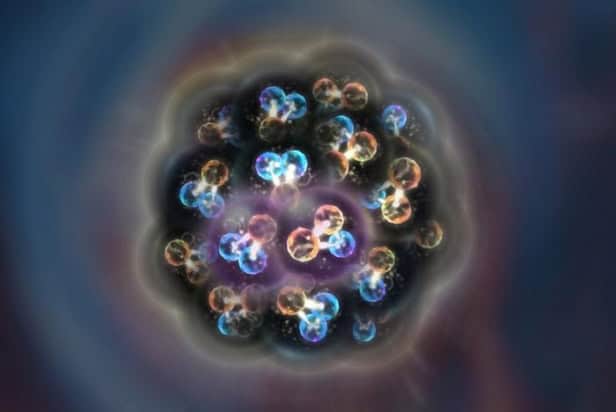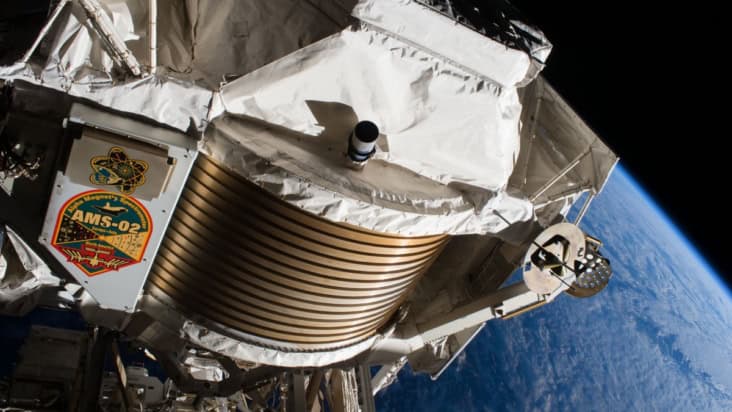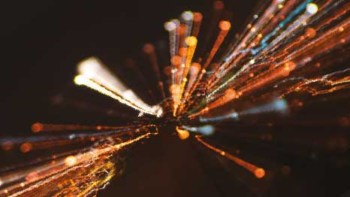

New for 2024: Physics World now has a newsletter dedicated to particle and nuclear physics. To sign up, go to My account then click on "My alerts".

Detection of antideuterons and antihelium could help hone dark-matter models
Tulika Bose, Philip Burrows and Tara Shears discuss proposals for the next big particle collider
 Read article: Mountaintop observations of gamma-ray glow could shed light on origins of lightning
Read article: Mountaintop observations of gamma-ray glow could shed light on origins of lightning
Electric fields near Earth’s surface are stronger than expected
 Read article: Enigmatic particle might be a molecular pentaquark
Read article: Enigmatic particle might be a molecular pentaquark
Decay rate of exotic hadron suggests it comprises five quarks
 Read article: Positronium gas is laser-cooled to one degree above absolute zero
Read article: Positronium gas is laser-cooled to one degree above absolute zero
New cooling technique could help reveal physics beyond the Standard Model
 Read article: Improved antiproton trap could shed more light on antimatter-matter asymmetry
Read article: Improved antiproton trap could shed more light on antimatter-matter asymmetry
Maxwell's demon cooling trap measures the magnetic moment of antiprotons with higher precision than ever before
 Read article: Quark distribution in light–heavy mesons is mapped using innovative calculations
Read article: Quark distribution in light–heavy mesons is mapped using innovative calculations
Form factors can be tested by collider experiments
 Read article: Heavy exotic antinucleus gives up no secrets about antimatter asymmetry
Read article: Heavy exotic antinucleus gives up no secrets about antimatter asymmetry
Antihyperhydrogen-4 is observed by the Star Collaboration

A step-by-step guide to publishing your research paper. Helping you get published and make an impact in your scientific community
 Read article: Fusion, the Web and electric planes: how spin-offs from big science are transforming the world
Read article: Fusion, the Web and electric planes: how spin-offs from big science are transforming the world
James McKenzie looks at some of the unexpected spin-offs from big science
 Read article: ‘Sometimes nature will surprise us.’ Juan Pedro Ochoa-Ricoux on eureka moments and the future of neutrino physics
Read article: ‘Sometimes nature will surprise us.’ Juan Pedro Ochoa-Ricoux on eureka moments and the future of neutrino physics
Particle physicist Juan Pedro Ochoa-Ricoux talks about how the next generation of neutrino experiments will test the boundaries of the Standard Model
 Read article: UK reveals next STEPs toward prototype fusion power plant
Read article: UK reveals next STEPs toward prototype fusion power plant
Engineers and physicists have met to discuss the challenges and opportunities of building a practical fusion power plant in the UK
 Read article: Fusion’s public-relations drive is obscuring the challenges that lie ahead
Read article: Fusion’s public-relations drive is obscuring the challenges that lie ahead
Guy Matthews says that the focus on public relations is masking the challenges of commercializing nuclear fusion
 Read article: LUX-ZEPLIN ‘digs deeper’ for dark-matter WIMPs
Read article: LUX-ZEPLIN ‘digs deeper’ for dark-matter WIMPs
Announcement makes us pine for the Black Hills
 Read article: Abdus Salam: honouring the first Muslim Nobel-prize-winning scientist
Read article: Abdus Salam: honouring the first Muslim Nobel-prize-winning scientist
Claudia de Rham and Ian Walmsley pay tribute to the contributions of the great theorist Abdus Salam
 Read article: Half-life measurement of samarium-146 could help reveal secrets of the early solar system
Read article: Half-life measurement of samarium-146 could help reveal secrets of the early solar system
Isotope is extracted from an accelerator target
 Read article: Multiple molecular hexaquarks are predicted by theoretical study
Read article: Multiple molecular hexaquarks are predicted by theoretical study
Exotic hadrons comprising six quarks could be observed in future experiments
 Read article: Quantum dot liquid scintillator could revolutionize neutrino detection
Read article: Quantum dot liquid scintillator could revolutionize neutrino detection
A new type of water-based scintillator made from quantum dots could make neutrino detectors safer and cheaper
 Read article: Heisenberg gets ‘let off the hook’ in new historical drama based on the Farm Hall transcripts
Read article: Heisenberg gets ‘let off the hook’ in new historical drama based on the Farm Hall transcripts
Philip Ball reviews Farm Hall by Katherine Moar at the Theatre Royal Haymarket, London, which runs until 31 August 2024
 Read article: CERN at 70: how the Higgs hunt elevated particle physics to Hollywood status
Read article: CERN at 70: how the Higgs hunt elevated particle physics to Hollywood status
Peering behind the comms curtain at the world's most famous particle physics lab
 Read article: Had a leak from your science facility? Here’s how to deal with the problem
Read article: Had a leak from your science facility? Here’s how to deal with the problem
Robert P Crease explains how Fermilab navigated an accidental leak of tritium
 Read article: CERN’s Science Gateway picked by Time magazine as one of the ‘world’s greatest places’ to visit
Read article: CERN’s Science Gateway picked by Time magazine as one of the ‘world’s greatest places’ to visit
The gateway ‘bridges the gap between the general public and the people in lab coats’
 Read article: Physicists detect nuclear decay in the recoil of a levitating sphere
Read article: Physicists detect nuclear decay in the recoil of a levitating sphere
Principle of momentum conservation makes it possible to "see" individual alpha particles leaving a micron-scale silica bead
 Read article: Radiation monitoring keeps track of nuclear waste contamination
Read article: Radiation monitoring keeps track of nuclear waste contamination
PhD studentship available to develop technologies for in situ characterization of nuclear fission products
 Read article: Rumours spread like nuclear fission, say physicists
Read article: Rumours spread like nuclear fission, say physicists
Neutrons are rumours and people are uranium isotopes in new model
 Read article: Smashing heavier ions creates superheavy livermorium
Read article: Smashing heavier ions creates superheavy livermorium
New technique brings an island of stability closer
 Read article: From new physics to sustainability, particle physics looks to the future
Read article: From new physics to sustainability, particle physics looks to the future
Katherine Skipper reports on 2024's International Conference on High Energy Physics in Prague